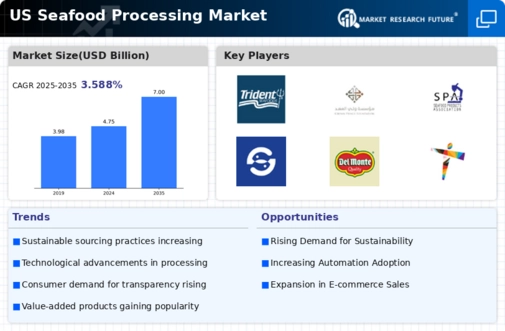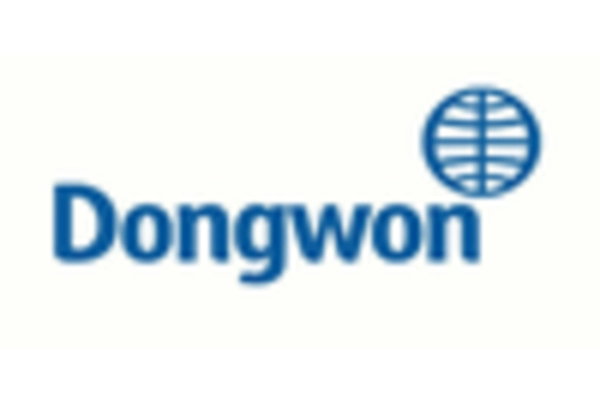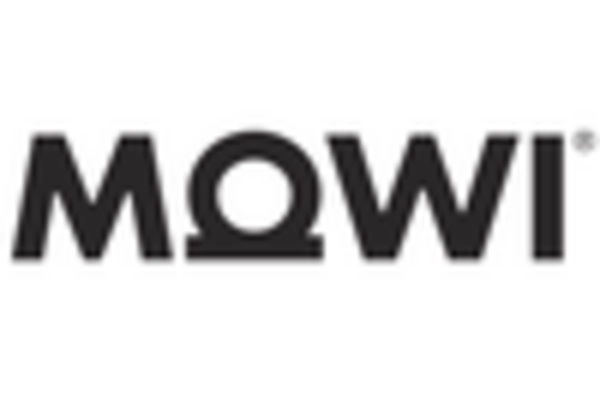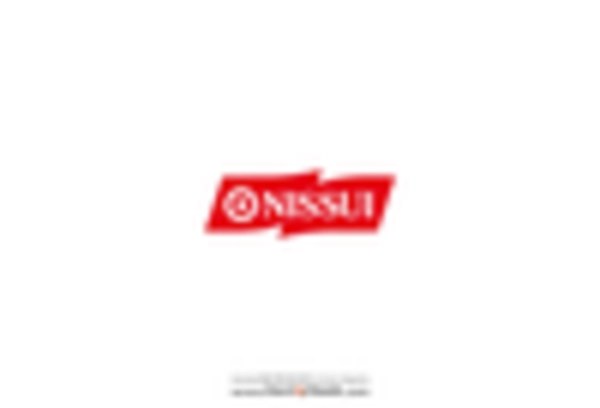Evolving Regulatory Frameworks
the seafood processing market is influenced by evolving regulatory frameworks that ensure food safety and sustainability.. In the US, agencies such as the FDA and NOAA enforce stringent guidelines regarding seafood sourcing, processing, and labeling. Compliance with these regulations is essential for market players to maintain consumer trust and avoid potential legal repercussions. Recent updates to regulations have focused on traceability and transparency in the supply chain, which are increasingly demanded by consumers. As a result, seafood processors are investing in systems that enhance traceability, ensuring that products are sourced sustainably and ethically. This regulatory landscape not only impacts operational practices but also shapes consumer perceptions, thereby influencing purchasing decisions in the seafood processing market.
Rising Consumer Demand for Seafood
The seafood processing market experiences a notable increase in consumer demand, driven by a growing awareness of the health benefits associated with seafood consumption. As consumers become more health-conscious, they are increasingly seeking protein-rich diets, which seafood provides. According to recent data, seafood consumption in the US has risen by approximately 15% over the past five years. This trend is likely to continue, as more individuals recognize seafood as a source of essential nutrients, including omega-3 fatty acids. Consequently, The seafood processing market must adapt to this rising demand. This includes enhancing production capabilities and ensuring the availability of diverse seafood products.. This shift not only supports the industry's growth but also encourages sustainable fishing practices, which are becoming increasingly important to consumers.
Innovations in Processing Technology
Technological advancements play a crucial role in shaping the seafood processing market. Innovations such as automated processing lines, advanced freezing techniques, and improved packaging solutions enhance efficiency and product quality. For instance, the adoption of high-pressure processing (HPP) technology has gained traction, allowing for the preservation of seafood while maintaining its nutritional value. This technology can extend shelf life by up to 50%, which is particularly beneficial in a market where freshness is paramount. Furthermore, the integration of data analytics and IoT in processing facilities enables better inventory management and quality control. As these technologies continue to evolve, they are expected to drive operational efficiencies and reduce waste, ultimately benefiting the seafood processing market.
Growth of E-commerce and Online Retail
The rise of e-commerce has transformed the seafood processing market, providing new avenues for distribution and consumer engagement. Online platforms enable seafood processors to reach a broader audience, catering to the increasing preference for home delivery and convenience. Recent statistics indicate that online seafood sales have surged by over 30% in the past year, reflecting a shift in consumer purchasing behavior. This trend is particularly pronounced among younger demographics, who favor the convenience of online shopping. As a result, seafood processors are adapting their marketing strategies to include digital channels, enhancing their online presence and offering direct-to-consumer sales. This shift not only expands market reach but also allows for better customer interaction and feedback, ultimately benefiting the seafood processing market.
Focus on Sustainable Sourcing Practices
Sustainability has emerged as a pivotal driver in the seafood processing market, with consumers increasingly prioritizing sustainably sourced products. The demand for eco-friendly seafood options is reflected in the growing popularity of certifications such as MSC and ASC, which assure consumers of responsible fishing practices. Recent surveys indicate that approximately 70% of consumers are willing to pay a premium for sustainably sourced seafood. This trend compels seafood processors to adopt sustainable sourcing practices, which not only align with consumer preferences but also contribute to the long-term viability of marine ecosystems. By investing in sustainable practices, the seafood processing market can enhance its reputation and appeal to environmentally conscious consumers, thereby fostering growth and resilience in a competitive landscape.

















Leave a Comment